Today we’re checking out Intel’s Core Ultra 5 245K, the successor to the mainstream Core i5-14600K. With a current retail price of $320, it competes directly with the recently released Ryzen 7 9700X, so we’re eager to see how these parts stack up in both productivity and gaming workloads.
Before diving into the benchmark data, let’s briefly review some of the key specifications for the Core Ultra 5 245K. We’ll omit much of the platform and testing details already covered in our Core 9 285K review. For more details about the platform changes in Intel’s latest CPU family, please check out that article first.
The 245K features 6 P-Cores, each with a single thread, as Hyper-Threading is no longer used. These P-Cores operate at a base frequency of 4.2 GHz, boosting up to 5.2 GHz – a minor 2% frequency reduction compared to the 14600K.
| Processor | Release price | P-core (performance) | E-core (efficiency) | L3 cache | ||||||
|---|---|---|---|---|---|---|---|---|---|---|
| Cores (threads) | Freq. | Turbo | L2 cache | Cores (threads) | Freq. | Turbo | L2 cache | |||
| Core Ultra 9 285K | $600 | 8 (8) | 3.7 GHz | 5.6 GHz | 24 MB | 16 (16) | 3.2 GHz | 4.6 GHz | 16 MB | 36 MB |
| Core Ultra 7 265K | $395 | 8 (8) | 3.9 GHz | 5.5 GHz | 12 (12) | 3.3 GHz | 12 MB | 30 MB | ||
| Core Ultra 5 245K | $310 | 6 (6) | 4.2 GHz | 5.2 GHz | 18 MB | 8 (8) | 3.6 GHz | 8 MB | 24 MB | |
| Core i9-14900K | $600 | 8 (16) | 3.2 GHz | 6.0 GHz | 16 MB | 16 (16) | 2.4 GHz | 4.4 GHz | 16 MB | 36 MB |
| Core i7-14700K | $420 | 8 (16) | 3.4 GHz | 5.6 GHz | 12 (12) | 2.5 GHz | 4.3 GHz | 12 MB | 33 MB | |
| Core i5-14600K | $330 | 6 (12) | 3.5 GHz | 5.3 GHz | 12 MB | 8 (8) | 2.6 GHz | 4.0 GHz | 8 MB | 24 MB |
For the E-Cores, there are 8 in total, also with 8 threads as there is no SMT support. These cores run at a base frequency of 3.6 GHz, with a maximum clock of 4.6 GHz, which represents a 15% increase over the E-Core frequency on the 14600K.
In total, there’s 24 MB of L3 cache and 26 MB of L2 cache. Each P-core has 3 MB of L2 cache, while the E-cores share 4 MB per cluster, with each cluster containing four E-cores. The base TDP is 125W, with a max turbo TDP of 159W. Intel is pricing this model at $310 per 1,000 units.

It’s also noteworthy that all K-SKU models – currently the only ones announced – support dual-channel DDR5-5600 UDIMM memory or DDR5-6400 CUDIMM memory. CUDIMM memory incorporates a small clock driver circuit on the module itself, which enables the precise timings necessary for higher memory speeds.
Each model provides 20 PCIe 5.0 lanes and 4 PCIe 4.0 lanes, along with a Direct Media Interface 4.0 with 8 lanes connecting to the chipset. As with other K-suffix processors, these models feature an unlocked multiplier for overclocking capabilities.
Test System Specs
| CPU | Motherboard | Memory |
| AMD Ryzen 7000 Series | Gigabyte X670E Aorus Master [BIOS F33d] | G.Skill Trident Z5 RGB 32GB DDR5-6000 CL30-38-38-96 Windows 11 24H2 |
| AMD Ryzen 5000 Series | MSI MPG X570S Carbon MAX WiFi [BIOS 7D52v19] | G.Skill Ripjaws V Series 32GB DDR4-3600 CL14-15-15-35 Windows 11 24H2 |
| Intel Core Ultra 200S | Asus ROG Maximus Z890 Hero [BIOS 0805] | G.Skill Trident Z5 CK 32GB DDR5-8200 CL40-52-52-131 G.Skill Trident Z5 RGB 32GB DDR5-7200 CL34-45-45-115 Windows 11 23H2 [24H2 = Slower] |
| Intel 12th, 13th & 14th | MSI MPG Z790 Carbon WiFi [BIOS 7D89v1E] | G.Skill Trident Z5 RGB 32GB DDR5-7200 CL34-45-45-115 Windows 11 23H2 [24H2 = Slower] |
| Graphics Card | Power Supply | Storage |
| Asus ROG Strix RTX 4090 OC Edition | Kolink Regulator Gold ATX 3.0 1200W | TeamGroup T-Force Cardea A440 M.2 PCIe Gen4 NVMe SSD 4TB |
| GeForce Game Ready Driver 565.90 WHQL | ||
Productivity Benchmarks
Cinebench Clock Behavior
First, let’s examine how the 265K behaves under load. For cooling, we’re using the new MSI MAG Coreliquid I360, provided in our review kit, which is specifically designed and optimized for these new Arrow Lake CPUs. MSI has developed a unique bracket that shifts the cold plate slightly north, resulting in a 3-degree temperature reduction by better targeting the hot spot on these CPUs.

With the Coreliquid I360 installed, we loaded up the 265K with Cinebench and observed an average clock frequency of 4.6 GHz on the E-Cores and 5.0 GHz on the P-Cores. This performance stayed within the stock 159W power limit, and the CPU’s peak core temperature reached just 66°C – well below the 105°C TjMAX.
Cinebench 2024, Multi-Core
In the Cinebench multi-core test, the 245K is 9% faster than the 14600K, making it 26% faster than the 9700X, an impressive outcome considering it’s slightly more affordable than the Ryzen 7 processor.

Cinebench 2024, Single Core
In single-core performance, the 245K matched the 9700X with a score of 137 points – a 12% increase over the 14600K.

Cinebench 2024 Power Consumption
While the 245K was 26% faster than the 9700X in the multi-core test, it also consumed 46% more power at 139 watts, which aligns with the power draw of models like the 7700X. However, this still represents a 37% reduction in power usage compared to the 14600K.

7-Zip File Manager Compression
When it comes to compression performance, the 245K underperforms slightly, being slower than the 14600K and only 8% faster than the 9700X, which is modest for a next-generation product.
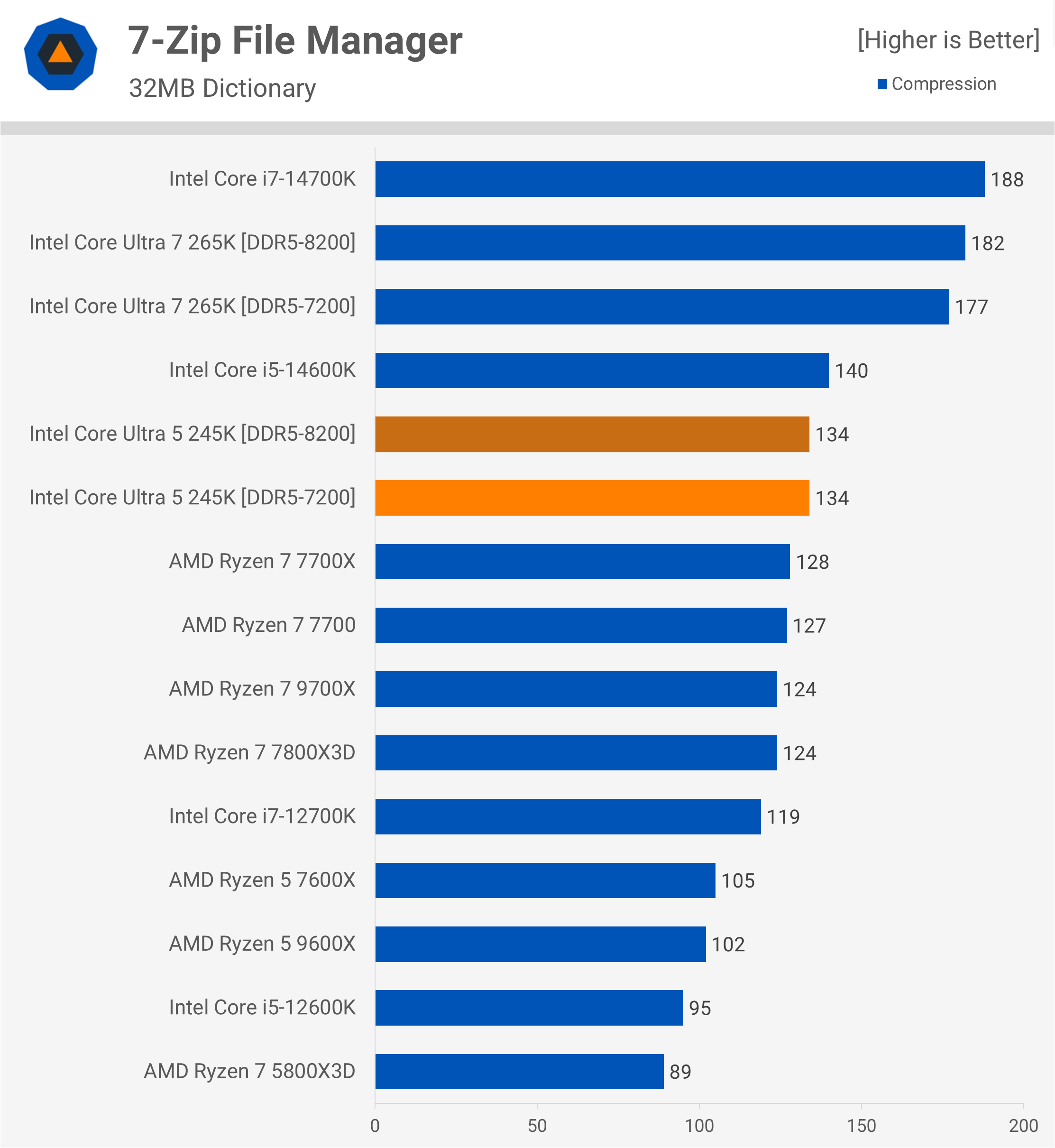
7-Zip File Manager Decompression
Decompression performance is even less impressive, with the 245K only matching older models such as the 12700K and 5800X3D. It is 12% slower than the 9700X and 13% slower than the 14600K.

Blender Open Data
Blender Open Data results show some improvement: the 245K is 7% faster than the 14600K and 16% faster than the 9700X, making it a solid option for budget-conscious rendering.
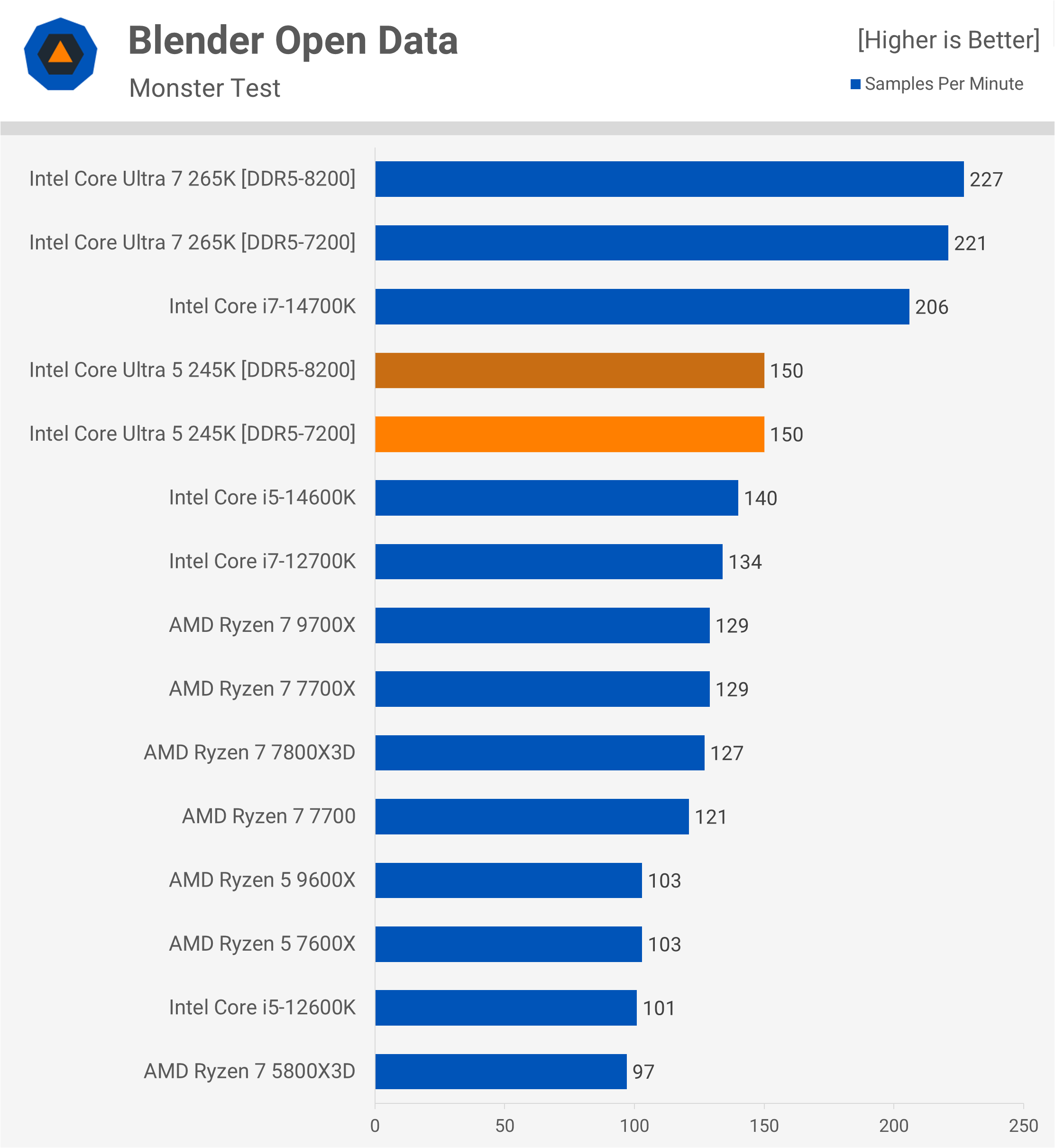
Corona 10 Benchmark
In the Corona 10 Benchmark, the 245K performs well, outperforming the 14600K by 7% and the 9700X by 11%. Although the margin isn’t vast, it’s still a performance gain.
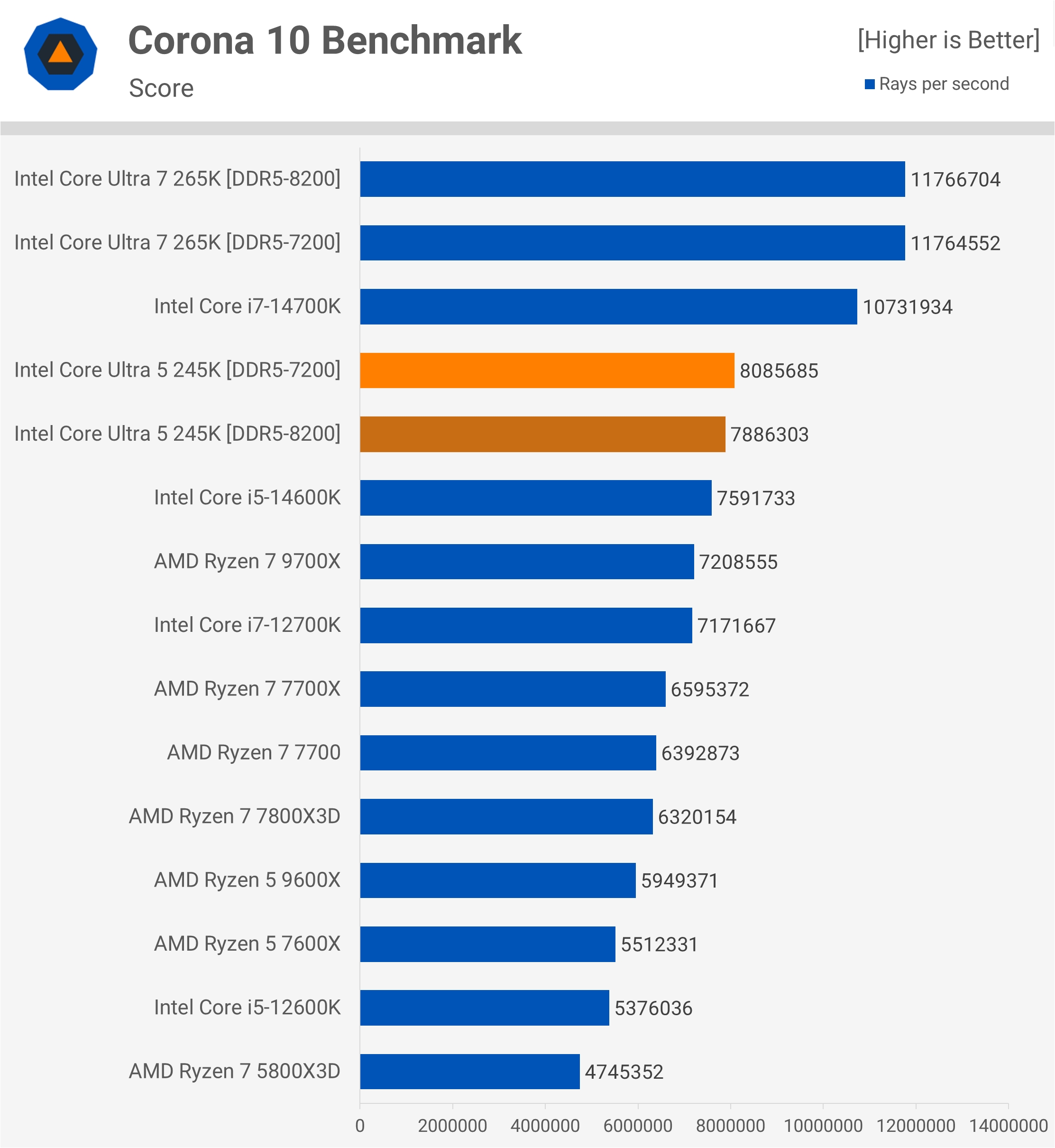
Adobe Photoshop 2025
After a few tweaks, we’ve improved the performance of the Arrow Lake CPUs in Photoshop, bringing them closer to expected levels once Windows 11 updates enhance support. Despite these adjustments, the 245K remains only 8% faster than the 14600K, and 10% slower than the 9700X, indicating room for improvement.

Adobe Premiere Pro 2024
The Premiere Pro results are much stronger; here, the 245K matches the 14700K, offering an 11% increase over the 14600K and a 14% improvement over the 9700X.

Gaming Benchmarks
Star Wars Jedi: Survivor
Starting with the gaming benchmarks, we begin with Star Wars Jedi: Survivor. Here, the 245K delivers underwhelming performance, reaching an average of only 142 fps with DDR5-7200 memory, which makes it 7% slower than the 14600K and 12% slower than the 9700X.

The Last of Us Part 1
The 245K performs significantly better in The Last of Us Part 1, matching the 9700X with an average of around 180 fps. The 1% lows were also notably improved. Compared to the 14600K, the 245K offers just a 2% performance gain.

Cyberpunk 2077: Phantom Liberty
Even with the “Prioritize P-Cores” option enabled in Cyberpunk 2077: Phantom Liberty, the 245K lags, trailing even the 12600K. This results in it being 16% slower than the 14600K and 17% slower than the 9700X – a disappointing outcome for a next-generation product. Ideally, Intel will address this performance gap in future updates.

Hogwarts Legacy
The results in Hogwarts Legacy are better but still modest. The 245K matches the 14600K, making it 8% slower than the 9700X.

Assetto Corsa Competizione
In Assetto Corsa Competizione (ACC), the 245K falls short again, trailing the 14600K by 5% and the 9700X by a significant 24%. Unfortunately, the 245K delivers performance more akin to the 12700K in this title.
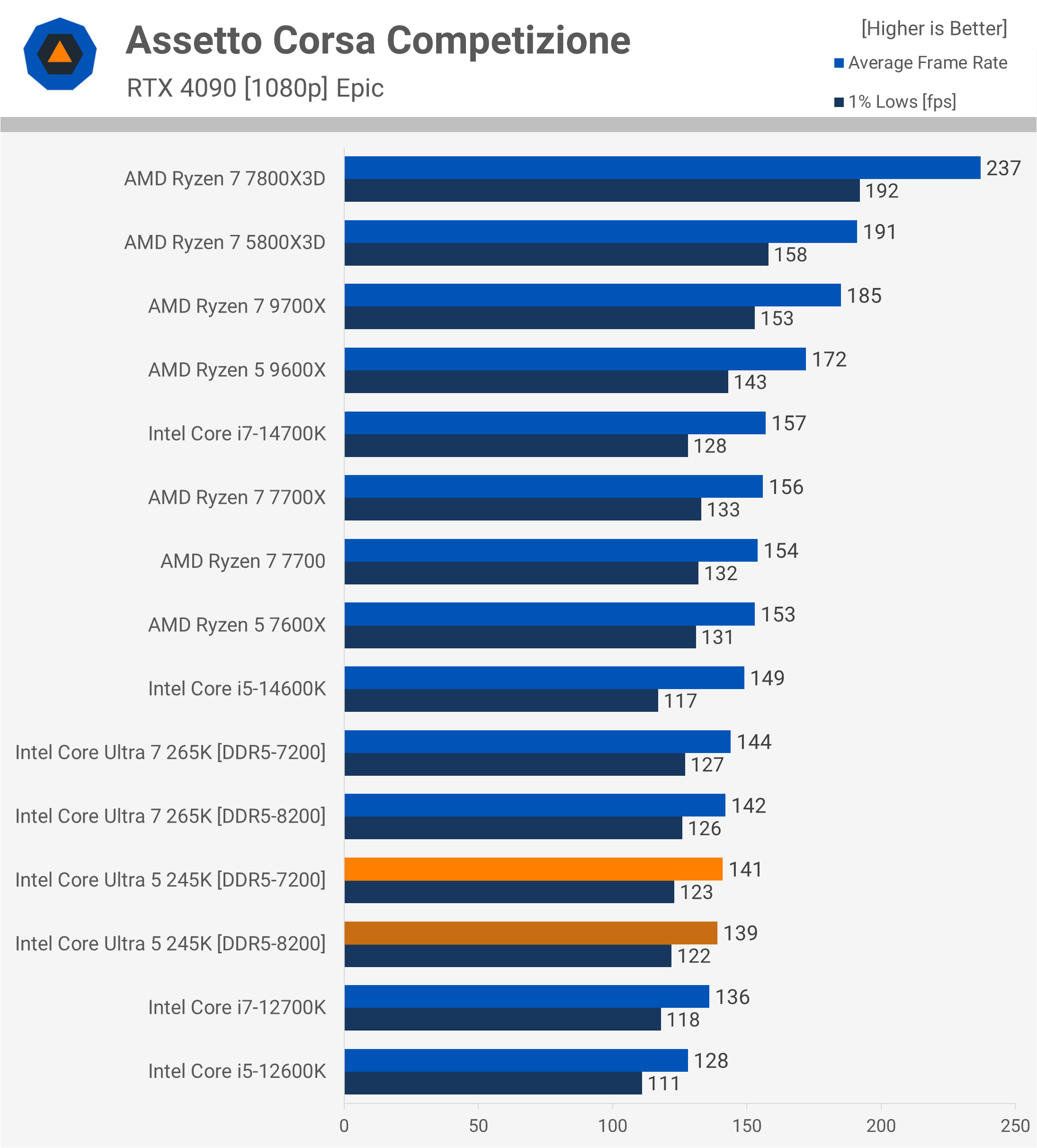
Remnant II
The 245K also struggles in Remnant II, averaging 112 fps – the same performance level as the previous-generation 14600K and 11% slower than the 9700X.

Homeworld 3
Intel CPUs consistently perform poorly in Homeworld 3, particularly with 1% lows, across all models from the 12th generation onward. The 245K is no exception, falling just behind the 14600K. Its average frame rate is 13% lower than the 9700X, and its 1% lows are down by 43%, marking another weak showing.

A Plague Tale: Requiem
The 245K also underperforms in A Plague Tale: Requiem, falling behind even the 12600K. It trails the 14600K by 17% and the 9700X by a substantial 27%, another area where Intel may need to investigate and address performance issues.

Counter-Strike 2
In Counter-Strike 2, the 245K again delivers performance similar to the 12700K, with an average of 400 fps. It is 13% slower than the 14600K and 24% slower than the 9700X.

Starfield
Starfield is one of the few games where the 245K performs reasonably well. While it only matches the 14600K – hardly impressive – this is one of its better results so far, even outpacing the 9700X by 10%. Zen 5 processors notably underperform in this title, which may explain the margin.
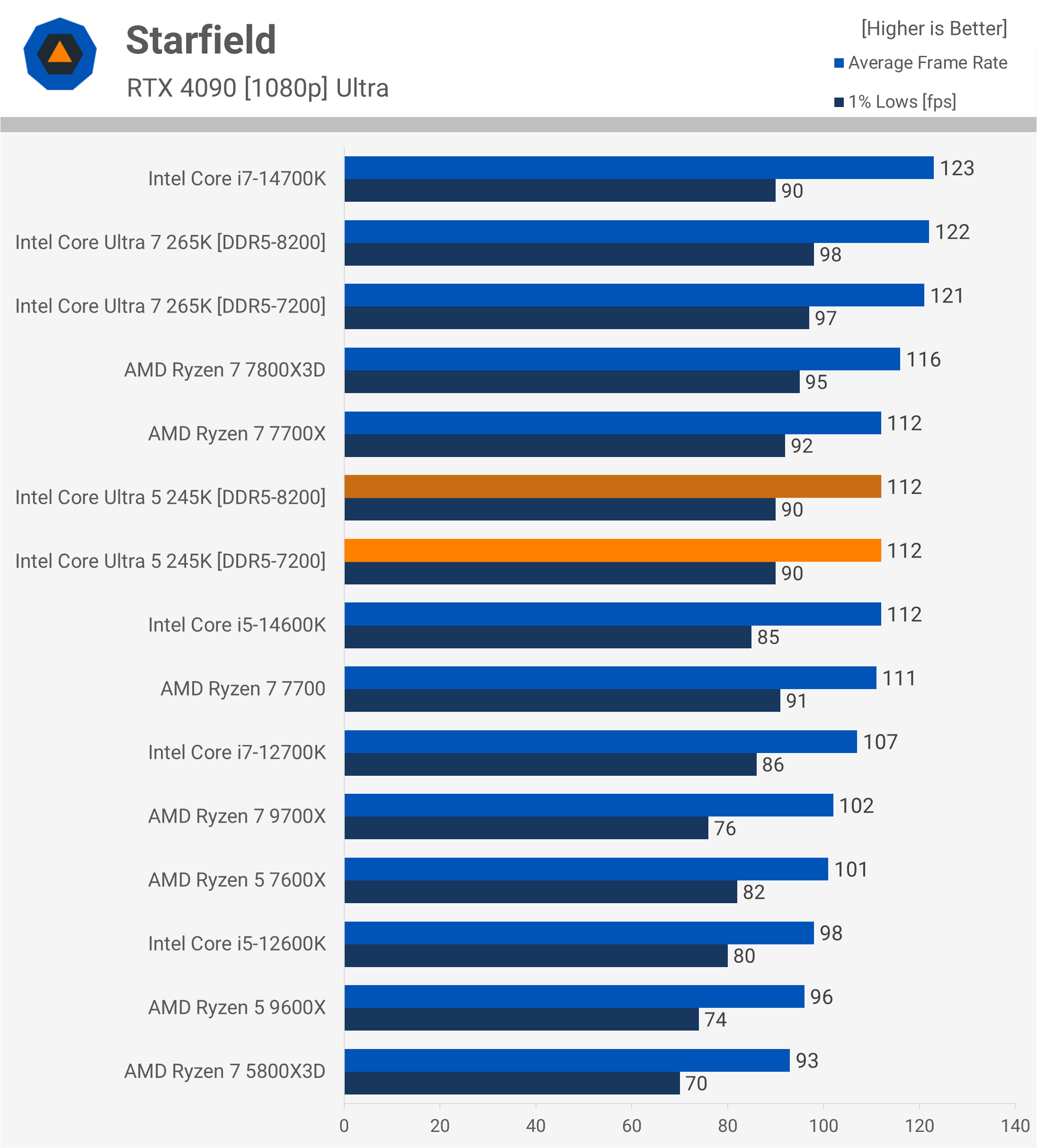
Warhammer 40,000: Space Marine 2
In Space Marine 2, the 245K lags behind both the 14600K and 9700X by about 6%, adding to the list of less-than-stellar results.

Hitman 3
Typically, Intel CPUs perform well in Hitman 3, but the Arrow Lake architecture does not hold up as well. The 245K is 9% slower than the 14600K and 4% slower than the 9700X.

Watch Dogs: Legion
Watch Dogs: Legion results are particularly poor for the 245K. It finishes last by a notable margin, trailing the 14600K by 20% and the 9700X by 23%.

Star Wars Outlaws
The 245K performs adequately in Star Wars Outlaws, achieving a 2% gain over the 14600K. While not remarkable, this is at least an improvement.
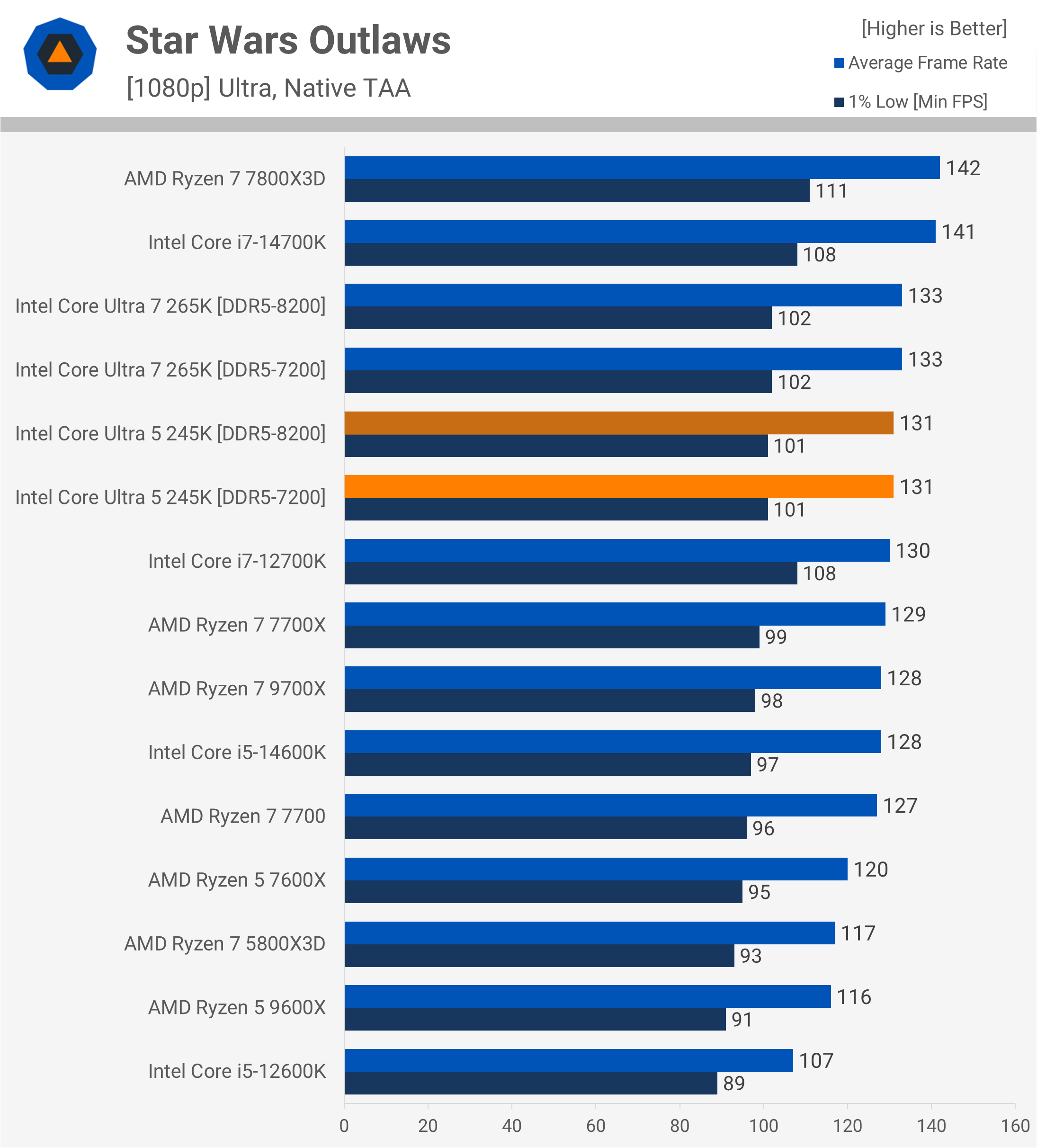
Gaming Power Consumption
Now for a quick look at power consumption when gaming. In Cyberpunk 2077, the 245K consumes just 73 watts – a 13% reduction compared to the 9700X. However, remember it is also 17% slower, so the Ryzen 7 part is more power-efficient here.


In The Last of Us Part 1, the 9700X and 245K consume similar levels of power, yielding roughly equivalent performance. The 245K edges out the 14600K by a few percentage points while reducing power consumption by a considerable 38%, making it notably more efficient than the previous generation.
14 Game Average
Across the 14 games tested, the 245K was, on average, 8% slower than the 14600K and 14% slower than the 9700X – disappointing results for a next-generation product. This performance level was achievable as far back as the 12700K release, while significantly better gaming performance can be found with the 5800X3D or several other Ryzen processors from both previous and current generations.

Cost Per Frame
The cost per frame also fails to impress. The 245K offers just 9% better value than the 7800X3D at its current inflated price tag of $475, though that CPU was available for as low as $340 not long ago, resulting in a cost per frame of just $1.65.

Currently, the 245K costs 14% more than the 9700X per frame and a substantial 36% more than the 14600K and 7700X, making it a poor value for gaming despite being a better value than the 265K and 285K.
What We Learned
Intel’s latest CPU generation has shown disappointing results overall, particularly for PC gamers. We had hoped the Core Ultra 5 245K might be a hidden gem, but sadly no. Like the rest of the lineup, it presents a mixed bag, with arguably more drawbacks than benefits at this point.
In terms of performance, productivity results were indeed better than in gaming, but even here, they were not exceptional. Outside of Cinebench and a few other rendering benchmarks, there is little to get excited about. Compression and decompression performance lagged behind the Core i5-14600K, though we did see reasonable gains in most other workloads, though the 245K didn’t always beat the 9700X.

Productivity performance is definitely a strong point for the 245K, and its power efficiency is also competitive, nearly matching AMD’s efficiency, so now they’re much the same in that regard.
Where the 245K truly struggled was in gaming performance. While Arrow Lake has generally underperformed here, the 245K was even more inconsistent. In some titles, it could roughly match the 265K, but in others, like Cyberpunk 2077, Counter-Strike 2, Hitman 3, and Watch Dogs: Legion, it lagged noticeably, often ranking near or at the bottom of our charts.
As a result, the Core Ultra 5 245K represents poor value, and you’d be much better off with a Core i5-14600K or, ideally, the Ryzen 7 7700X. For gamers, the 245K simply isn’t a viable option without a substantial price reduction and more consistent performance. Realistically, the price would need to drop to $250 to make it a consideration, and even then, “a consideration” is perhaps a more accurate description than “an attractive option.”

Essentially, it would need to reach the current price of the 14600K, and even then, it’s not an obvious choice over the typically faster Core i5. The power savings are a nice benefit, but the 14600K’s efficiency isn’t overly concerning – certainly less so when compared to a model like the 7700X. In regions with moderate power costs, most users wouldn’t find the 14600K’s power draw problematic, as it’s still relatively easy to cool.
That said, we rarely recommended the 14600K anyway; for similar pricing, the 7700X generally offers better gaming performance with substantially lower power consumption.
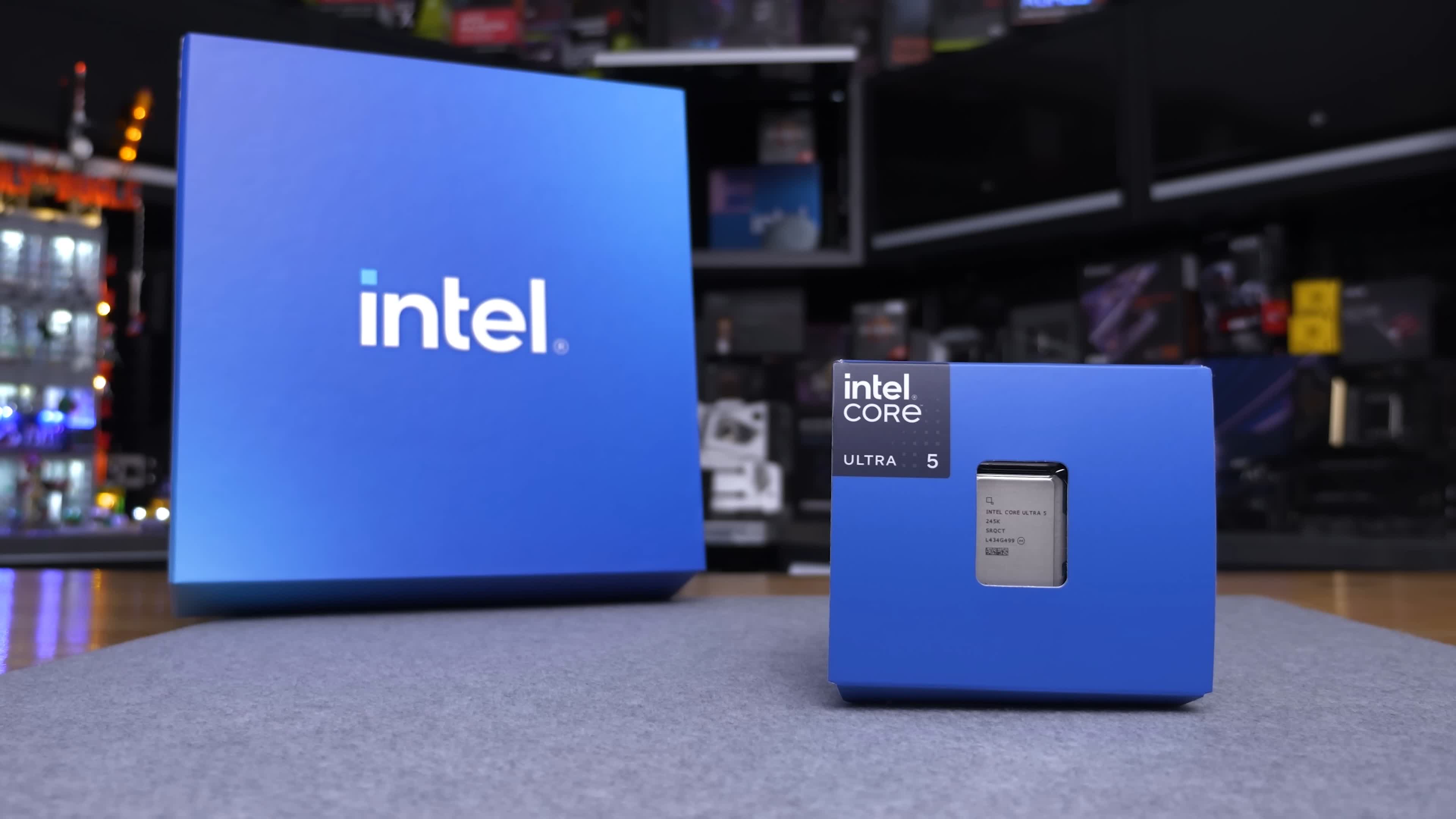
But in a world where neither the 7700X nor the 14600K exist, the Core Ultra 5 245K would still have to compete with the Ryzen 7 9700X. AMD’s chip generally offers faster and more consistent gaming performance. In productivity, the 245K has a slight edge, especially in core-heavy workloads, though the difference isn’t always significant. For strictly core-heavy productivity tasks, the 245K does look more appealing.
However, those specifically interested in core-heavy productivity are likely to look beyond the 245K.
For $320, the 245K does represent decent productivity performance although there are better alternatives available. Hopefully, Intel can address Arrow Lake’s issues soon, as there seems to be untapped potential here, but until we see improvements, these CPUs remain difficult to recommend.
Shopping Shortcuts:
- Intel Core Ultra 5 245K on Amazon
- Intel Core Ultra 7 265K on Amazon
- AMD Ryzen 7 7700X on Amazon
- AMD Ryzen 7 9700X on Amazon
- Intel Core i7-14700K on Amazon
- AMD Ryzen 7 7800X3D on Amazon
- AMD Ryzen 5 9600X on Amazon


